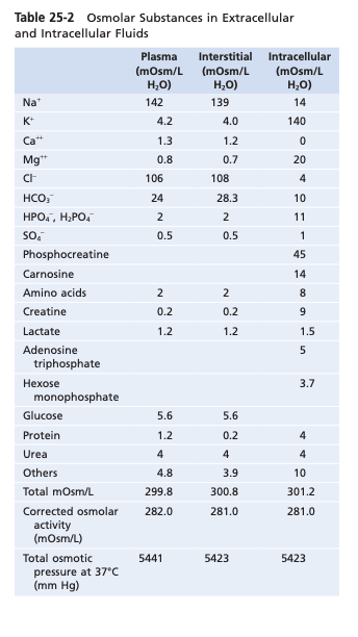I1i / 22B11: Describe the body fluid compartments
22B11: Exam Report
Describe the body fluid compartments
25% of candidates passed this question.
This question was answered poorly.
Many answers provided incorrect facts relating to the body fluid compartments, their approximate sizes, the factors that regulate and contribute to those sizes and their constituents.
Total body water was often incorrectly calculated and associated with limited explanation as to the factors that may affect it
I1i / 22B11: Describe the body fluid compartments
Body Water Content
In the ‘70 kg patient’ Total Body Water (TBW) is 42L
Total body water can vary depending on age (decreased in eldery, makes up majority of body mass in infants), obesity (increased total body water but lower proportion of body mass due to increased adipose) and gender (M > F).
Fluid Compartments
Body fluids can be classified into specific compartments; separated from each other by a physical barrier


Intracellular fluid
Intracellular fluid – 55% of TBW – 23L
- Consists of all fluids within the cell membranes
- Osmolality 290 mosm/kg
- In mmol/L: K 150, PO4 100, proteins +++
- Smaller amounts of other electrolytes – Na 100, Cl 3, HCO3 10, Mg 0.5, Ca < 0.01
- Regulated by movement of free fluid between compartments which is determined by extracellular osmolality (with sodium and chloride being the main osmotically active solutes in extracellular fluid)
Extracellular fluid
Extracellular fluid – 45% of TBW – 19L, consists of all fluids outside the cell membrane,
- In mmol/L: Na 140, Cl 100-105
- Smaller amounts – HCO3 27, K 3-5, Ca 1.1, PO4 1.1, Mg 0.5, proteins +
- Osmolality 290 mosm/kg
- Regulated by movement of sodium and other electrolytes via both active and passive transport (diffusion, facilitated transport, active transport).
- Volume controlled in a sensor (low and high pressure baroreceptors, intra-renal baroreceptors, osmoreceptors), integrator (hypothalamus), effectors (renal regulation of sodium – glomerulotubular balance, RAAS, renal SNS stimulation, ADH, ANP) system.
Extracellular Fluid Components
- Interstitial fluid – 20% or 8.4L
- Bathes all cells in body and links their intracellular fluid with plasma volume
- Composition is similar to plasma volume but decreased protein composition
- Returns to systemic circulation via lymphatic system.
- Intravascular fluid – 7.5% or 3.2L
- Plasma is the non cellular component of blood
- Communicates with interstitial fluid by vascular endothelium, determined by Starling forces involving hydrostatic and oncotic pressures.
- Water in dense connective tissue – 7.5% or 3.2L
- Water in bone – 7.5% or 3.2L
- Transcellular fluid 2.5% – 1L
- Diverse group of fluids including CSF, bile, joint fluid, aqueous humour, bowel fluid, bladder urine
- Have special physiological roles in body
- Are in contact with intracellular fluid across an epithelial cell membrane
- Formed by specific cellular transport activity in epithelial spaces
Author: Michael Wu